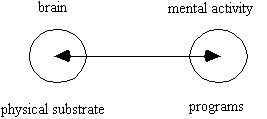
Fig. 3
We may consider a mental informational field
on account of the telepathy phenomenon and because such a field
may contribute to the integrating activity of the brain. The substance
in the universe is obviously discontinuous. The nervous system
is built of this discontinuous substance and yet we can pass to
continuity at a mental level. However, we cannot speak of a subjective
continuum. We have already seen that matter appears to be continuous
in profundities. Hence, there exists an underlying principle of
the continuum, which changes into one of the discontinuum as soon
as substance, i.e. the elementary particles, are at play. In a
way, the elementary particles are a concoction of the deep continuum
and of the discontinuum in the universe. The space originating
with the universe, hence with the elementary particles, can only
be discontinuous, whereas the space particles contain the same
continuum seed pertinent to the profound matter. By virtue of
the theory of relativity, the space may be treated as a continuum,
given that we regard it against the panel of the mental continuum.
Einstein observed that "The object of any science, whether
a science of nature or psychology, is to coordinate our states
of consciousness and incorporate them into a logical
system"12.
Einstein states that the space may be cogitated as a
continuum13
as a result of an historical experience. The whole theory of relativity
develops upon postulating the continuum of space and time
in their inseparable unity: "continuum spatii et temporis
est absolutum"14.
However, the postulation of the continuum is not subjective; it
mirrors an objective continuum and also the observation of what
has discontinuous forms in the continuum.

Fig. 4
The discontinuum and the continuum appearas combined realities in the material
world. The immediate questionis where and how these realities combine. First,
upon the birthof the elementary particles, then most likely in certain molecular
aggregates which assume a living character. No continuous integration
can be virtually made if we only operate in terms of the discontinuous,
unless the "shells" of the elementary particles get
somehow dissolved so as to make the continuum accessible to us.
Let us now see what phenomenon could allow the elementary particles
to get free of their shells. This phenomenon must no doubt be
rather ordinary and must develop upon certain combinations of
atoms, hence in the case of molecules under certain conditions.
That is why by virtue of the experience gained thus far this thing
must in all likelihood happen even in the most elementary molecular
aggregate provided that it should behave like a living one. Finally,
this might also happen in a chemical molecule under conditions
which should allow it to have access to the informaterial field
so that the informational field may be safely involved in the
functioning of the whole. Like associations are also found in
quantum mechanics where the common electrons of two or more atoms
are responsible for the chemical bounds. We may now righteously
ask whether informaterial associations might not arise under certain
conditions.
The above stated might suggest the idea that
the brain-informatter coupling cannot occur in the macroscopic
structure of the brain. It appears more likely that this coupling
occurs in molecules and hence the chemical activity of the brain
should virtually be extremely important in brain functioning and
in the development of the basic properties of the brain.
Matter in Depths21







